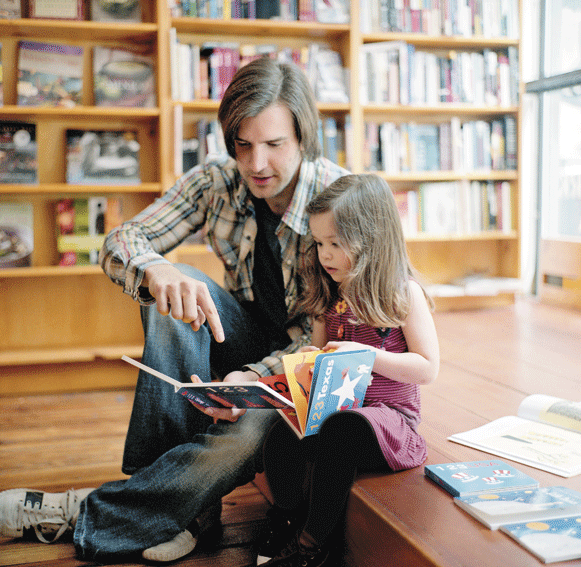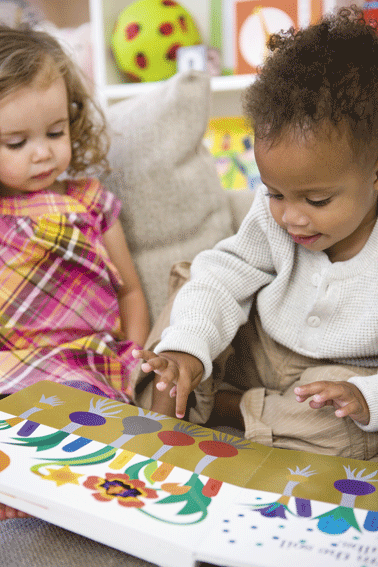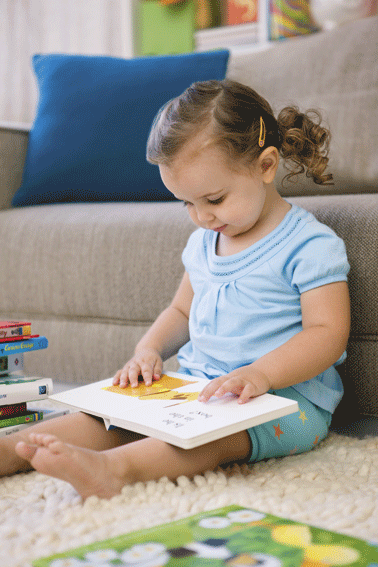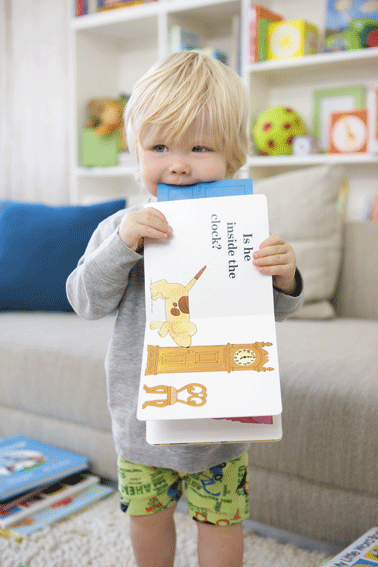

Get Your Child
Hooked on Books
 |
This month Parents launches a yearlong reading initiative with Jumpstart, a nonprofit early-education organization, and the International Reading Association (IRA),
a group of literacy educators. Our guide has great ideas for bringing up a book lover.
By Logan Ward
When I wanted to learn the secret for getting kids psyched about reading, I knew one expert I had to ask: my daughter, Eliot. She doesn’t have a Ph.D. and isn’t an author (except for those self-published titles with the construction-paper covers). But at age 6, she’s become a bona fide bookworm, burying her head in the latest Magic Tree House title at every free moment. Did it develop from daily circle time at preschool? By watching Between the Lions? Eliot’s answer surprised me: “It’s all about the stories? I can imagine myself in them, and they make me want to keep reading.”
Since every child has her own taste in genres, your job is to find it—and nurture it. “Getting your kid excited about books is one of the greatest gifts you can give her,” says Kathryn Au, Ph.D., president of the IRA. Turn the page to get started.
Birth to12 Months
Snuggling with your baby as you look at picture books teaches her to associate reading with comfort. “You can read the phone book, and she’d be happy because she has your total attention,” explains noted children’s author
Jon Scieszka, the Library of Congress National Ambassador for Young People’s Literature.
Slow down. “Parents have a tendency to read too quickly,” says Jim Trelease, author of The Read-Aloud Handbook. Pronounce each word, and pause for a beat between every sentence. This helps set a comfortable pace, and it gives older children time to absorb the story, which will spark their imagination.
Be a narrator. Help your child connect objects to words by naming things around the house and explaining your actions (“I’m putting your toys away”).
Find the rhythm. Pat or clap as you read to promote your baby’s natural sense of rhythm. Try books with a beat, such as The Wheels on the Bus, by Paul O. Zelinsky, and Hand, Hand, Fingers, Thumb, by Al Perkins.
Play peekaboo(k). Be engaging as you read, since your child may not be getting much from the narrative. Try facing him while he’s in a bouncy seat. As you read, move the book up and down in front of your face and smile. “This lets him see your excitement and makes the experience more fun,” says Pam Allyn, founder of LitLife, a literary-education organization, and author of What to Read When.
Embrace repetition. Rereading favorites builds a baby’s confidence. Plus, your child will learn more each time you go through them.
look for
Durable board books (chewing and throwing are normal at this age) and soft, waterproof ones for the bath.
Few to no words.
Pictures of easily recognizable objects, like balls, bottles, and other babies.
Patterns and strong color contrasts, since an infant’s eyesight is still developing.
1 to 2 Years
As your child becomes mobile, he revels in discovery. Keep toddler titles around the house (even in the kitchen) so he can look at them whenever he wants and you can squeeze a little reading into the margins of your day, says Kim Davenport, senior vice president of education and program at Jumpstart.
Put her in control. Grab a book, hold it, turn the pages, close it, and return it to the shelf. Then see whether she can do the same.
Show your playful side. Use silly voices and make animal noises. Hamming it up will get your child excited about the story.
Relate to his routine. When your child is getting dressed, read a book about clothing. Ask, “What is Elmo going to wear?” and “Are you going to wear blue pants today too?”
Get into construction. If you’re reading a Richard Scarry book, take out some blocks and recreate the fictional Busytown together. Or ask your child if she wants to build a house for Frog and Toad.
Make a baby book. Use photos of your child and write simple, repetitive captions (“Baby sleeps, baby eats, baby smiles, baby grows and grows and grows”).
look for
Images of animals or kids doing familiar activities.
Rhymes and repetitive phrases.
Questions posed to the reader.
Pop-up pages for an interactive experience.
3 to 4 Years
As your child’s coordination improves, she’ll begin making marks on a page, a critical stage in her reading readiness. “Drawing and pretend writing help your child grasp the complex process of reading,” says J. Richard Gentry, Ph.D., author of the forthcoming Raising Confident Readers. You can help: Provide easy access to crayons, markers, and other drawing materials. And ask her to make a picture to go with a story she likes—not a copy, but her interpretation.
Point to it. Run your finger beneath the print on a page as you read. Your child will start to realize that the sounds you make come from the letters he sees.
Talk it out. Ask questions that will evoke a thoughtful response (“Why do you think she feels angry?”). Explain new words and concepts, but try to keep the story flowing.
Go on a listening journey. Visit a noisy playground or a quiet corner of your neighborhood. Instruct your child to let you know when she hears a noise. Then have her mimic the sound and try to write it down (as you coach her to “sound it out”).
Serve it up. Prepare food that relates to the story you’re reading. Have your child make pancakes with you when you read If You Give a Pig a Pancake, or munch on thick slices of toast with jelly as you turn the pages of Bread and Jam for Frances.
Come up with a craft. The next time you take out The Very Hungry Caterpillar, create antennae using pom-poms, a headband, and pipe cleaners. Have your child wear it every time you read the book.
Let him scribble. If your child won’t sit still and listen, see whether keeping his hands busy with a pencil and paper reduces his fidgeting.
“Even adults doodle when they talk on the phone,” says Trelease.
Make the most of TV time. Yes, you read that right. As your child watches Dora the Explorer, activate the closed-caption feature. Over time she may start to connect the dialogue with the words.
Build a book nook. It needn’t be fancy, just cozy. A corner with pillows, stuffed animals, and a book basket will do fine.
look for
Simple text a child can memorize as she begins to recognize words.
New characters (such as the clever pig from My Lucky Day) and settings (such as Botswana, where Honey … Honey … Lion! takes place) to broaden kids’ horizons.
Stories about making friends, going to school, or visiting the doctor.
More complex tales for read-alouds.
5 to 6 Years
By now you may be reading chapter books to your child. But when she’s sounding out words on her own, go with easier material. Look for titles with short, rhyming words, such as Dr. Seuss’s Hop on Pop or Green Eggs and Ham. “Let her choose what she likes, so she’ll be more motivated to read,” says Davenport. Praise even minor progress, and stop at the earliest sign of fatigue.
Have your child set the pace. Don’t worry if a book seems babyish. It’s better for your child to stay within his comfort zone. He’ll let you know when he’s ready for the next level. 
Expand your definition of books. If your child prefers reading comic books to fairy tales, experts say that’s fine. Bruce Dorries, of Staunton, Virginia, credits Pokémon cards with motivating his son to read at age 5. “Mitchell and his friends would lie on the living-room floor for hours, spouting facts and poring over the tiny type, just like my brother and I used to do with baseball cards,” says Dorries.
Take a field trip. Read about plants or wildlife before going to a nature center. When you visit a science museum, pick up a book about experiments you can do at home. And if you take your kids to a historic site, see whether the gift shop has a children’s title that lets them learn more about it.
Give “bonus” book time. Place a lamp near your child’s bed, and on weekends let him stay up 15 minutes past his regular bedtime to read.
Act it out. Role-play the stories you’ve read. Search
the dress-up box for a princess gown or a policeman’s
uniform. Let your child practice for a while, then record
her performance. Play it back for the whole family.
Publish his work. Have your child take photos with a sturdy digital camera. Print them out, and then see whether he can write a story to go with them. Bind the pages between a homemade cover, and add the book to your home library.
Start a kids’ book club. Invite some of your child’s buddies over for a reading party. Plan a skit or an art activity. Let them take turns reading, then talk about the characters over pizza.
Time her. If your child gets frustrated by reading aloud, set a timer for three minutes and have her stop when it buzzes, says Allyn. Add a minute every few days as her confidence builds.
Stay by his side. A first-grader can often understand books written on a fourth-grade level if Mom or Dad reads them to him. Just because your child starts reading by himself doesn’t mean you should stop doing it together.
look for
No more than
five unfamiliar
words per page.
Recurring characters and themes, such as in series like Amelia Bedelia and Arthur.
Longer chapters
and more challenging story lines for reading together.